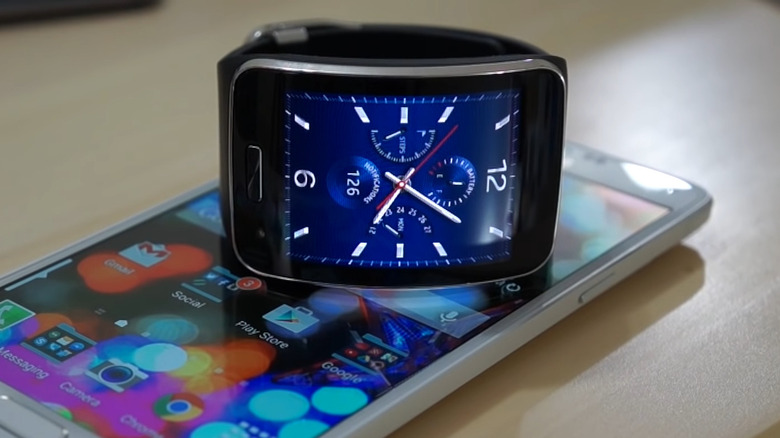A Look Back At The Samsung Galaxy Gear S: What Made It Unique?
Smartwatches have seen quite an evolution over the years in both functionality and design. In both categories, none quite stands out like the wireless wearable hands-on Samsung Gear S. Released in late 2014, this device pushed boundaries in its aim to replicate as many of the features possible that make Samsung Galaxy phones the Android flagship to beat. The most notable feature of this item was its massive 2.2-inch Super AMOLED display, which was both touchscreen and curved to fit easily around the user's wrist.
The smartphone comparison wasn't limited to its look. Unlike some smartwatches that need to be tethered to a smartphone for certain functions, the Gear S could take calls and texts on its own with an individualized phone number that ran on your carrier's cellular network, or you could also connect it to your Samsung phone. Practically anything you could do on your smartphone, from playing games to browsing the internet to listening to music, could be accomplished on this nifty gadget with enhanced interactivity like nothing before or since.
While not a full-on replacement for a smartphone, it made for a good option if you were ever without your device. The effort to make this smartwatch perform as much like a smartphone as possible is ultimately what helped it stay unique nearly a decade later. But all good things must come to an end.
How does the Samsung Galaxy Gear S differ from later models?
There's no denying that the Samsung Gear S stands out from the crowd even today. Sadly, its overall performance didn't always mesh with its ambition. The surprisingly complex user interface, inconsistent standalone capabilities, and requirement for a monthly plan separate from your smartphone in order to use those capabilities halted this device from reaching its full potential.
Since the release of the following year's Gear S2, all Samsung smartwatch models have reverted to a more conventional rounded design. As a result of the size reduction, these versions lack much of the interactive quality that you could get with the wider Gear S display. However, the newer models still host many of the same apps and functions.
As time has gone on, however, Samsung's smartwatches have been hitting their stride. More recent models such as the Galaxy Watch 5 and Watch 6 have struck a largely successful balance of display size, app variety, health-tracking features, and durability. Today, you won't be able to connect the original Gear S to any Samsung smartphones made past 2020 anyway. That's because modern Samsung devices switched from running on Tizen to Wear OS, which finally fixed many smartwatch limitations. Nevertheless, the Samsung Gear S will always hold a unique place in the hearts of tech enthusiasts for its daring ambition.

